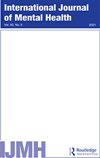Mental health profiles of women at high-risk for postpartum depression: a latent profile analysis
IF 1.7
Q3 PSYCHOLOGY, CLINICAL
引用次数: 1
Abstract
Abstract Understanding the heterogeneity of risk to Postpartum Depression (PPD) is of clinical and public health relevance, bearing in mind that symptom patterns are core therapeutic targets. Therefore, this study aimed to (1) ascertain mental health symptom profiles in women at high-risk for PPD, and (2) determine group differences in symptom configuration by cognitive-interpersonal variables. The sample for this study included 1013 postpartum women, who were identified as being at high-risk for PPD during the first three to four months postpartum. A Latent Profile Analysis (LPA) was performed to determine the number of mental health profiles. Significant mean differences on covariates across profiles were also tested, using the BCH approach. Results from the LPA revealed three profiles: (1) “Moderate Mental Health” (moderate depression/anxiety, moderate positive mental health); (2) “Good Mental Health” (low psychopathology, high positive mental health); and (3) “Impaired Mental Health” (high depression/anxiety, low positive mental health). These three profiles differed significantly by levels of emotion regulation, psychological flexibility, maternal self-efficacy, and partner relationship satisfaction. Altogether, these findings provide crucial evidence for three heterogeneous patterns of mental health symptoms in women at high-risk for PPD. This clinical variability stresses the relevance of taking symptom constellations into account for personalized prevention and treatment.产后抑郁症高危女性的心理健康状况:潜在状况分析
摘要了解产后抑郁症(PPD)风险的异质性具有临床和公共卫生相关性,要记住症状模式是核心治疗目标。因此,本研究旨在(1)确定PPD高危女性的心理健康症状特征,以及(2)通过认知人际变量确定症状配置的群体差异。这项研究的样本包括1013名产后妇女,她们在最初的三到四年中被确定为PPD的高危人群 产后数月。进行潜在特征分析(LPA)以确定心理健康特征的数量。还使用BCH方法测试了各剖面协变量的显著平均差异。LPA的结果揭示了三种情况:(1)“中度心理健康”(中度抑郁/焦虑,中度积极的心理健康);(2) “良好的心理健康”(低精神病理学,高积极心理健康);以及(3)“心理健康受损”(高度抑郁/焦虑、积极性低的心理健康)。这三种情况在情绪调节、心理灵活性、母亲自我效能感和伴侣关系满意度方面存在显著差异。总之,这些发现为PPD高危女性的三种不同类型的心理健康症状提供了重要证据。这种临床变异性强调了将症状星座纳入个性化预防和治疗的相关性。
本文章由计算机程序翻译,如有差异,请以英文原文为准。
求助全文
约1分钟内获得全文
求助全文
来源期刊

INTERNATIONAL JOURNAL OF MENTAL HEALTH
PSYCHOLOGY, CLINICAL-
CiteScore
3.80
自引率
20.00%
发文量
32
期刊介绍:
The official journal of the World Association for Psychosocial Rehabilitation, the International Journal of Mental Health features in-depth articles on research, clinical practice, and the organization and delivery of mental health services around the world. Covering both developed and developing countries, it provides vital information on important new ideas and trends in community mental health, social psychiatry, psychiatric epidemiology, prevention, treatment, and psychosocial rehabilitation.
 求助内容:
求助内容: 应助结果提醒方式:
应助结果提醒方式:


